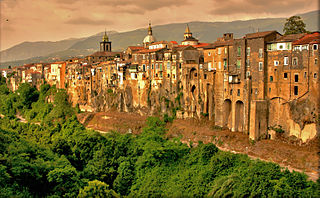
Pandulf I Ironhead was the Prince of Benevento and Capua from 943 until his death. He was made Duke of Spoleto and Camerino in 967 and succeeded as Prince of Salerno in 977 or 978. He was an important nobleman in the fight with the Byzantines and Saracens for control of the Mezzogiorno in the centuries after the collapse of Lombard and Carolingian authority on the Italian Peninsula. He established himself over almost the whole of the southern half of Italia before his death in March 981.
Richard Drengot was the count of Aversa (1049–1078), prince of Capua and duke of Gaeta (1064–1078).
Pandulf II the Old was the prince of Benevento from 981 and prince of Capua from 1008 or 1009 to his death, the son of Landulf III who was co-prince between 959 and 968. Pandulf was first associated as co-prince in 977.
Atenulf I, called the Great, was the prince of Capua from 7 January 887 and of Benevento from 899, when he conquered that principality. He also used the title princeps gentis Langobardorum: "prince of the Lombard people," an echo of the title used by the earliest prince of Benevento following the collapse of Lombard cohesion in 774.
Atenulf III, called Atenulf of Carinola, was the co-prince of Capua and Benevento from 933, when his father, Landulf I, and uncle, Atenulf II, made him so. His younger brother Landulf the Red succeeded co-prince Atenulf in 939 or 940. When the elder Landulf died on 10 April 943, the younger Landulf removed his elder brother Atenulf to Benevento and his uncle Atenulf's son Landulf to Capua. Fearing for their lives, the two fled to Guaimar II of Salerno and Landulf the Red became sole prince.

Landulf VII, also numbered Landulf IV or V, called Landolfo di Sant'Agata, was the prince of Capua from 1000 to his death. He was the second son of Landulf III of Benevento, who was only a co-ruler. Thus, he was easily removed from the succession on his father's death. His brother Pandulf eventually succeeded in becoming Prince of Benevento.
Pandulf III was the prince of Benevento in the Mezzogiorno in medieval Italy, first as co-ruler with his father, Landulf V, and grandfather, Pandulf II, from 1012 or thereabouts to 1014, when the elder Pandulf died. He co-ruled with his father until his death in 1033. Thereafter he was the primary ruler until his abdication in 1059.
Landulf VI was the last prince of Benevento. Unlike his predecessors, he never had a chance to rule alone and independent. The principality lost its independence in 1051, at which point Landulf was only co-ruling with his father, Pandulf III.

The Lombard Principality of Salerno was a South Italian state, formed in 851 out of the Principality of Benevento after a decade-long civil war.
The Principality of Capua was a Lombard state centred on Capua in Southern Italy, usually de facto independent, but under the varying suzerainty of Western and Eastern Roman Empires. It was originally a gastaldate, then a county, within the principality of Salerno.
Aloara of Capua, was a Princess regnant of Capua jointly with her son from 982 until 992. She was said to have governed her states with great ability.
The Landulfids or Atenulfings were a noble family of Lombardic origin in the ninth through eleventh centuries. They were descended from Landulf I of Capua, whose own ancestry is unknown and who died in 843. The dynasty produced a line of princes which ruled most of southern Italy at one time or another and even one pope, Victor III.






